Page 180 of 307
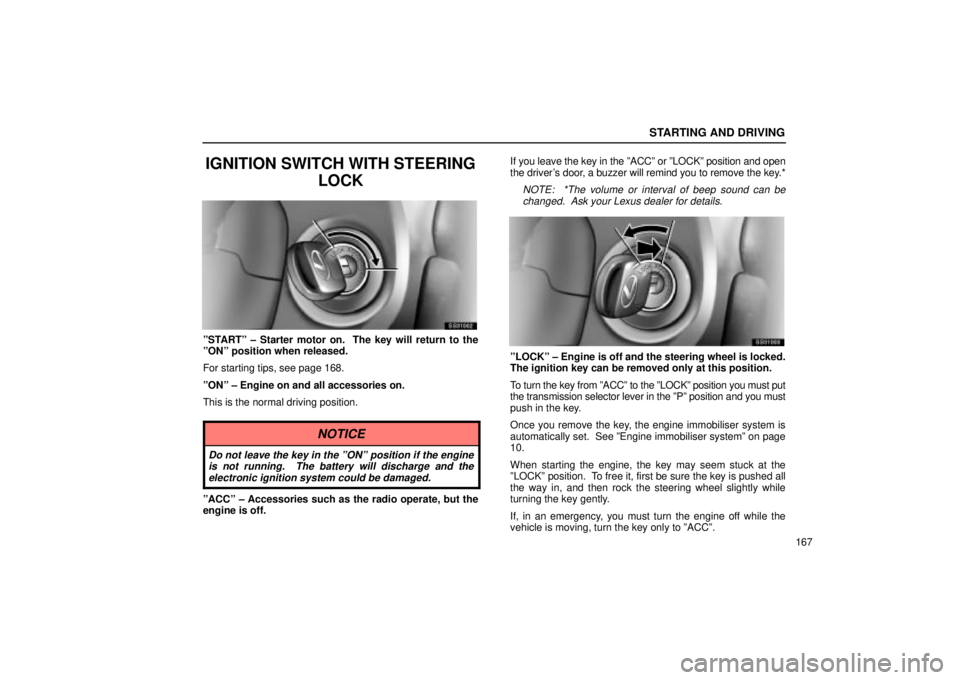
STARTING AND DRIVING
167
IGNITION SWITCH WITH STEERINGLOCK
SS31002
ºSTARTº ± Starter motor on. The key will return to the
ºONº position when released.
For starting tips, see page 168.
ºONº ± Engine on and all accessories on.
This is the normal driving position.
NOTICE
Do not leave the key in the ºONº position if the engine
is not running. The battery will discharge and theelectronic ignition system could be damaged.
ºACCº ± Accessories such as the radio operate, but the
engine is off. If you leave the key in the ºACCº or ºLOCKº position and open
the driver's door, a buzzer will remind you to remove the key.*
NOTE: *The volume or interval of beep sound can be
changed. Ask your Lexus dealer for details.
SS31003
ºLOCKº ± Engine is off and the steering wheel is locked.
The ignition key can be removed only at this position.
To turn the key from ºACCº to the ºLOCKº position you must put\
the transmission selector lever in the ºPº position and you must
push in the key.
Once you remove the key, the engine immobiliser system is
automatically set. See ºEngine immobiliser systemº on page
10.
When starting the engine, the key may seem stuck at the
ºLOCKº position. To free it, first be sure the key is pushed all
the way in, and then rock the steering wheel slightly while
turning the key gently.
If, in an emergency, you must turn the engine off while the
vehicle is moving, turn the key only to ºACCº.
Page 181 of 307
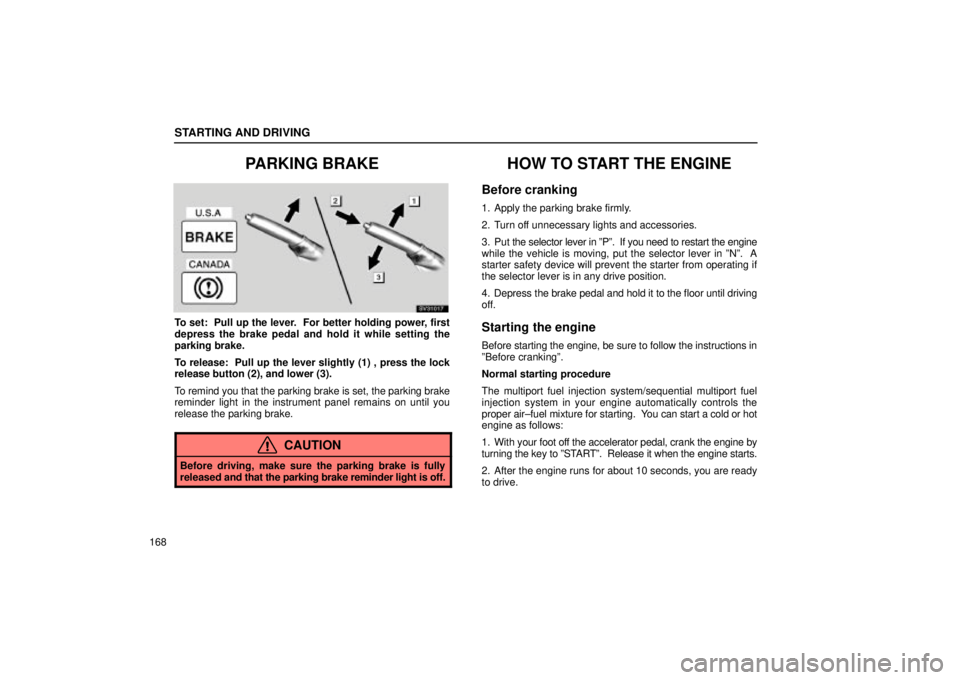
STARTING AND DRIVING
168
PARKING BRAKE
SV31017
To set: Pull up the lever. For better holding power, first
depress the brake pedal and hold it while setting the
parking brake.
To release: Pull up the lever slightly (1) , press the lock
release button (2), and lower (3).
To remind you that the parking brake is set, the parking brake
reminder light in the instrument panel remains on until you
release the parking brake.
CAUTION
Before driving, make sure the parking brake is fully
released and that the parking brake reminder light is off.
HOW TO START THE ENGINE
Before cranking
1. Apply the parking brake firmly.
2. Turn off unnecessary lights and accessories.
3. Put the selector lever in ºPº. If you need to restart the engine
while the vehicle is moving, put the selector lever in ºNº. A
starter safety device will prevent the starter from operating if
the selector lever is in any drive position.
4. Depress the brake pedal and hold it to the floor until driving
off.
Starting the engine
Before starting the engine, be sure to follow the instructions in
ºBefore crankingº.
Normal starting procedure
The multiport fuel injection system/sequential multiport fuel
injection system in your engine automatically controls the
proper air±fuel mixture for starting. You can start a cold or hot
engine as follows:
1. With your foot off the accelerator pedal, crank the engine by
turning the key to ºSTARTº. Release it when the engine starts.
2. After the engine runs for about 10 seconds, you are ready
to drive.
Page 183 of 307
STARTING AND DRIVING
170�
The shift position is displayed on the instrument
cluster.
P: Parking, engine starting and key removal position
R: Reverse position
N: Neutral position
D: Normal driving position (Shifting into overdrive
possible)
M: Position for manual shifting up or downshifting
When the cruise control is being used, even if you
downshift from ºDº to ºMº, engine braking will not be
enabled because the cruise control is not cancelled. For
the operation to decrease the vehicle speed, see page
182.
3, 2: Position for more powerful engine braking
L: Position for maximum engine braking Correct use of the automatic transmission is explained in
the following parts.
(a) Normal driving
(b) Driving in M mode
(c) Using engine braking
(d) Using the º3º, º2º and ºLº positions
(e) Backing up
(f) Parking
(g) Good driving practice
(h) Rocking your vehicle if stuck
(i) If you cannot shift the selector lever
(j) If the ºECT PWRº indicator light flashes
Page 184 of 307
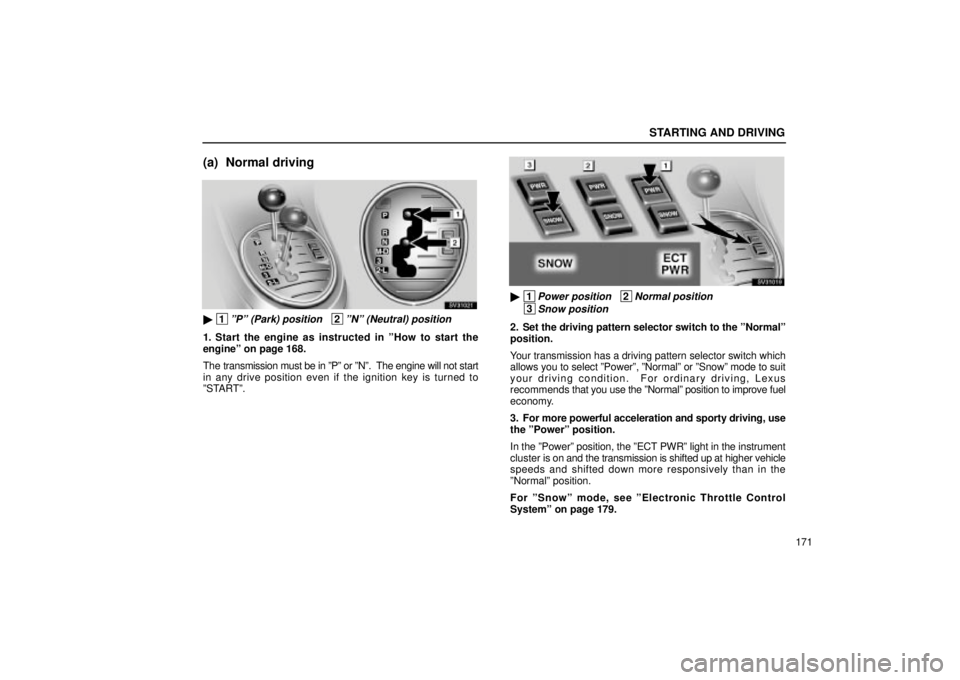
STARTING AND DRIVING
171
(a) Normal driving
SV31021
� 1ºPº (Park) position 2ºNº (Neutral) position
1. Start the engine as instructed in ºHow to start the
engineº on page 168.
The transmission must be in ºPº or ºNº. The engine will not start
in any drive position even if the ignition key is turned to
ºSTARTº.
SS31019
� 1Power position 2Normal position
3Snow position
2. Set the driving pattern selector switch to the ºNormalº
position.
Your transmission has a driving pattern selector switch which
allows you to select ºPowerº, ºNormalº or ºSnowº mode \
to suit
your driving condition. For ordinary driving, Lexus
recommends that you use the ºNormalº position to improve fuel
economy.
3. For more powerful acceleration and sporty driving, use
the ºPowerº position.
In the ºPowerº position, the ºECT PWRº light in the instrument\
cluster is on and the transmission is shifted up at higher vehicle
speeds and shifted down more responsively than in the
ºNormalº position.
For ºSnowº mode, see ºElectronic Throttle Control
Systemº on page 179.
Page 187 of 307
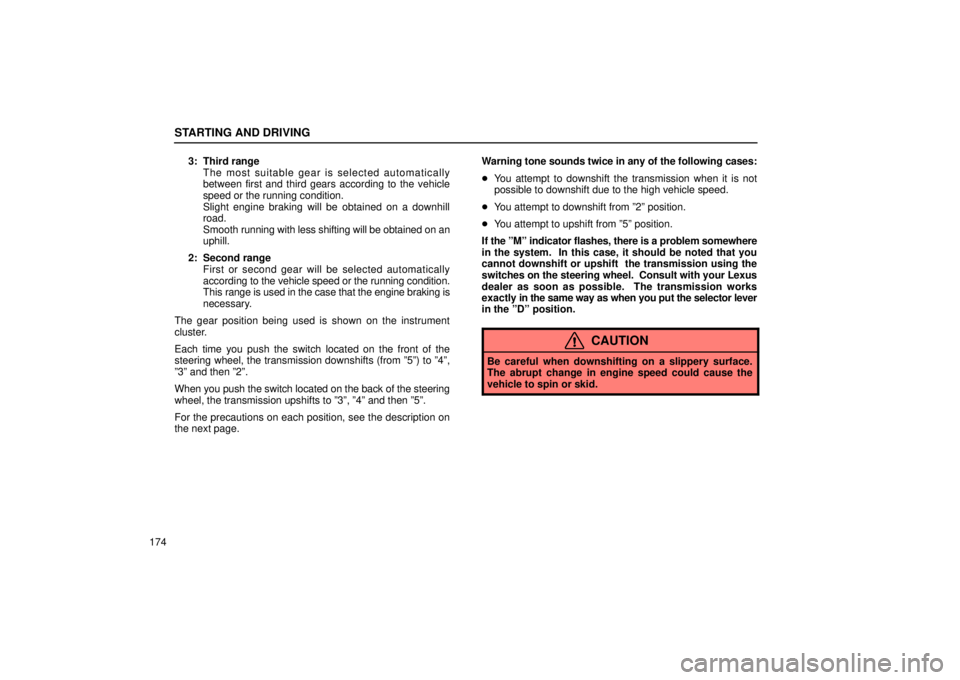
STARTING AND DRIVING
1743: Third range
The most suitable gear is selected automatically
between first and third gears according to the vehicle
speed or the running condition.
Slight engine braking will be obtained on a downhill
road.
Smooth running with less shifting will be obtained on an
uphill.
2: Second range First or second gear will be selected automatically
according to the vehicle speed or the running condition.
This range is used in the case that the engine braking is
necessary.
The gear position being used is shown on the instrument
cluster.
Each time you push the switch located on the front of the
steering wheel, the transmission downshifts (from º5º) to º4º\
,
º3º and then º2º.
When you push the switch located on the back of the steering
wheel, the transmission upshifts to º3º, º4º and then º5º\
.
For the precautions on each position, see the description on
the next page. Warning tone sounds twice in any of the following cases:
�
You attempt to downshift the transmission when it is not
possible to downshift due to the high vehicle speed.
� You attempt to downshift from º2º position.
� You attempt to upshift from º5º position.
If the ºMº indicator flashes, there is a problem somewhere
in the system. In this case, it should be noted that you
cannot downshift or upshift the transmission using the
switches on the steering wheel. Consult with your Lexus
dealer as soon as possible. The transmission works
exactly in the same way as when you put the selector lever
in the ºDº position.
CAUTION
Be careful when downshifting on a slippery surface.
The abrupt change in engine speed could cause the
vehicle to spin or skid.
Page 191 of 307
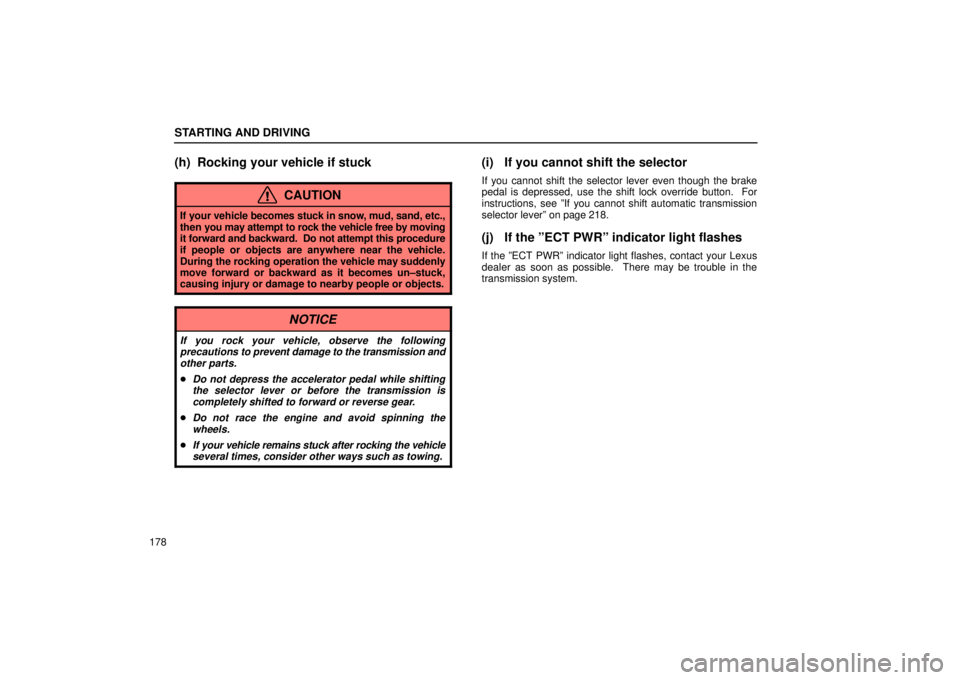
STARTING AND DRIVING
178
(h) Rocking your vehicle if stuck
CAUTION
If your vehicle becomes stuck in snow, mud, sand, etc.,
then you may attempt to rock the vehicle free by moving
it forward and backward. Do not attempt this procedure
if people or objects are anywhere near the vehicle.
During the rocking operation the vehicle may suddenly
move forward or backward as it becomes un±stuck,
causing injury or damage to nearby people or objects.
NOTICE
If you rock your vehicle, observe the following precautions to prevent damage to the transmission and
other parts.
�Do not depress the accelerator pedal while shifting the selector lever or before the transmission iscompletely shifted to forward or reverse gear.
�Do not race the engine and avoid spinning thewheels.
�If your vehicle remains stuck after rocking the vehicleseveral times, consider other ways such as towing.
(i) If you cannot shift the selector
If you cannot shift the selector lever even though the brake
pedal is depressed, use the shift lock override button. For
instructions, see ºIf you cannot shift automatic transmission
selector leverº on page 218.
(j) If the ºECT PWRº indicator light flashes
If the ºECT PWRº indicator light flashes, contact your Lexus
dealer as soon as possible. There may be trouble in the
transmission system.
Page 192 of 307
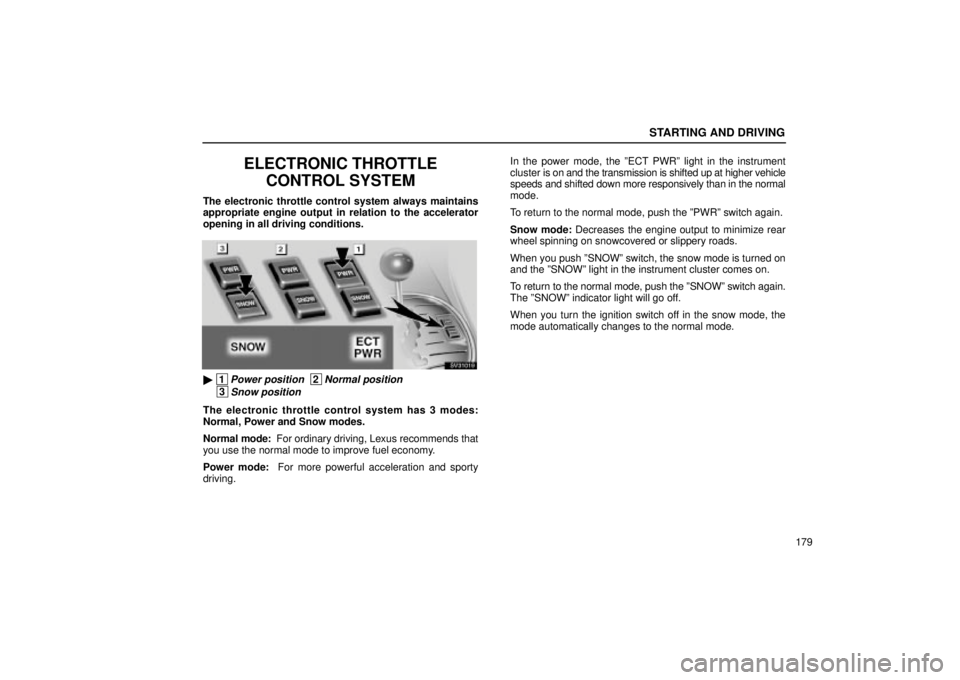
STARTING AND DRIVING
179
ELECTRONIC THROTTLECONTROL SYSTEM
The electronic throttle control system always maintains
appropriate engine output in relation to the accelerator
opening in all driving conditions.
SV31019
� 1Power position 2Normal position
3Snow position
The electronic throttle control system has 3 modes:
Normal, Power and Snow modes.
Normal mode: For ordinary driving, Lexus recommends that
you use the normal mode to improve fuel economy.
Power mode: For more powerful acceleration and sporty
driving. In the power mode, the ºECT PWRº light in the instrument
cluster is on and the transmission is shifted up at higher vehicle
speeds and shifted down more responsively than in the normal
mode.
To return to the normal mode, push the ºPWRº switch again.
Snow mode: Decreases the engine output to minimize rear
wheel spinning on snowcovered or slippery roads.
When you push ºSNOWº switch, the snow mode is turned on
and the ºSNOWº light in the instrument cluster comes on.
To return to the normal mode, push the ºSNOWº switch again.
The ºSNOWº indicator light will go off.
When you turn the ignition switch off in the snow mode, the
mode automatically changes to the normal mode.
Page 193 of 307
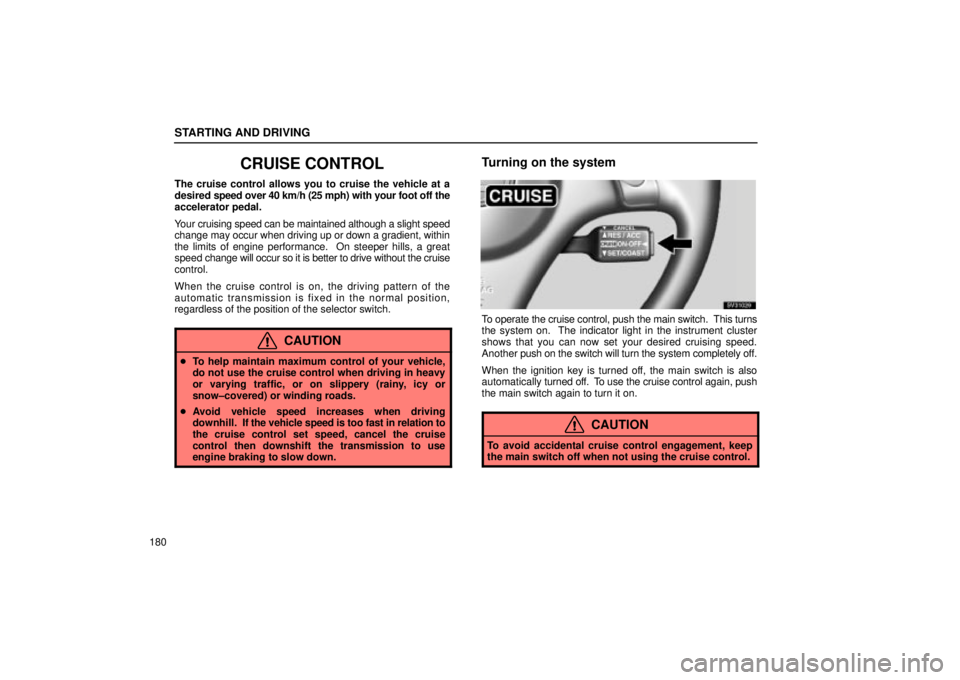
STARTING AND DRIVING
180
CRUISE CONTROL
The cruise control allows you to cruise the vehicle at a
desired speed over 40 km/h (25 mph) with your foot off the
accelerator pedal.
Your cruising speed can be maintained although a slight speed
change may occur when driving up or down a gradient, within
the limits of engine performance. On steeper hills, a great
speed change will occur so it is better to drive without the cruise
control.
When the cruise control is on, the driving pattern of the
automatic transmission is fixed in the normal position,
regardless of the position of the selector switch.
CAUTION
� To help maintain maximum control of your vehicle,
do not use the cruise control when driving in heavy
or varying traffic, or on slippery (rainy, icy or
snow±covered) or winding roads.
� Avoid vehicle speed increases when driving
downhill. If the vehicle speed is too fast in relation to
the cruise control set speed, cancel the cruise
control then downshift the transmission to use
engine braking to slow down.
Turning on the system
SV31029
To operate the cruise control, push the main switch. This turns
the system on. The indicator light in the instrument cluster
shows that you can now set your desired cruising speed.
Another push on the switch will turn the system completely off.
When the ignition key is turned off, the main switch is also
automatically turned off. To use the cruise control again, push
the main switch again to turn it on.
CAUTION
To avoid accidental cruise control engagement, keep
the main switch off when not using the cruise control.